CHINA - impressive history and stormy present by Klaus Metzger (top 10 novels of all time txt) 📖

- Author: Klaus Metzger
Book online «CHINA - impressive history and stormy present by Klaus Metzger (top 10 novels of all time txt) 📖». Author Klaus Metzger
As a drink, Chinese tea has been pre-served only once. Then, each guest received a complimentary glass of beer (coke , etc.). Who would want to drink another glass, had a large bottle of beer buy (at a price 15-30 yuan - on the cruise ship " Blue Whale "). Mostly we shared the bottle on each other and took alternately payment. Since we had booked for the entire round trip half board (only on the cruise ship " Blue Whale" was served full board) ever after inspection during a lunch or a dinner.
If the dinner turned out, we bought fruit and drinks reasonably priced in the small shops that were close to our respective hotels . Excellent was the beverage supply in our coach: there were 10 yuan for three small bottles of chilled mineral water. When getting out, we were besieged by poor Chinese who collected the empty bottles to should they make to money. Normally you drink tap water in China. Therefore, all visited hotels (and the cruise ship) in the bathroom had reserved two bottles of water daily for the morning toilet.
After this first day in Beijing, and the very interesting impressions we were glad that we were able to put us around 19 clock for sleeping in bed. Unfortunately, the night was around 23 clock 30 is again at the end, as the " jet lag " had caught up with us. However, we were able to fall asleep around 2 clock again and were taken at 6 clock from our alarm clock from our dreams. This went on four consecutive nights until we adapted ourselves.
On the second day in Beijing, we were relatively early and were the first guests in the breakfast restaurant (at 6 clock 45) - only some Asian businessmen came a bit earlier. We were able to orient ourselves in peace and laugh about the yogurt to the small spoon missing. So we learned that the Chinese suck this with a small tube from the beaker (with a second vent hole in the aluminum lid). After a few misunderstandings we get then but little spoon.

The Great Wall at Badaling
Around 8 clock started our bus for a tour of the Great Wall of China. The section of the Great Wall at Badaling is about 60 km away from Beijing (in north), and is very easy to reach from the motorway. This famous building is over 6,000 km long and was built during the Ming Dynasty (1368-1644) in its present form. You should fend off attacks by the Mongols from the north. There are two ways to climb the Great Wall: west it runs very steep and somewhat flatter in the east. Take the same approach to the Chinese. We were approached by many Chinese as "long nose model" for the group photo to be available.

Ming Emperor Yongle
Towards the subsequent visit to the Ming Tombs, we visited the motorway restaurant "Friendship Store" in Changping. The food was excellent and I ate with chopsticks for the first time (it was quite good). Afterwards we visited near the Ming Tombs (50 km northwest of Beijing). Particularly impressive was the Changling, the final resting place of Emperor Yongle (1403-1424). This reconstructed grave is empty however. His burial site is the first of the Ming Tombs. 13 Ming emperors were buried over a period of 200 years here.
Since 1368 was Nanjing (Nanking), the capital of the new Ming Dynasty. The son of the first Ming Emperor felt in the succession passed over as his nephew was preferred. In 1402 he defeated him and moved as the third Ming emperor " Yongle " the residence back to Beijing. On the ruins of the former Mongol palace he had to build the famous imperial city. In 10 years, the huge palace, which is still called the " Forbidden City " was born, and was precisely aligned in north-south direction.
In the funeral hall with the large monument of the Yongle Emperor, I found a reference to a huge Chinese fleet of 62 ships with 27,000 crew members, the seven expeditions to Java, Sumatra, India, Sri Lanka, in the Persian Gulf and eventually into the Red and has conducted sea to East Africa. I thought the Emperor himself would have led these expeditions. But this was one of the most famous eunuchs of the Ming Dynasty, Zheng He. He had risen to the Admiral , and made a name for himself as an explorer in the years 1405-1433. After the Ming Emperor issued an edict for unknown reasons against further voyages and the Chinese ships disappeared from the oceans.
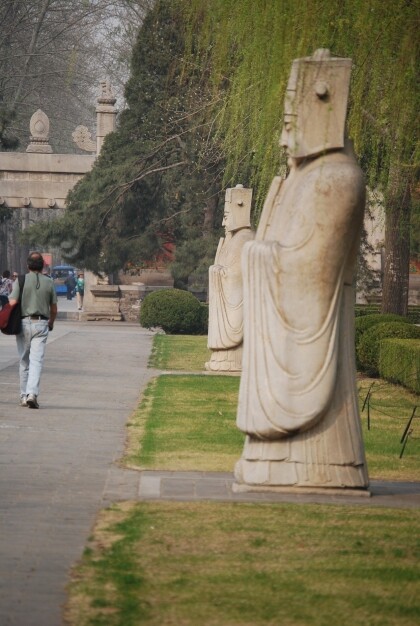
" Sacred Way "

" Avenue of Sphinxes "
Then we drove on to the so-called Sacred Way and went it in the " wrong " direction to the Great Red Gate. The sacred path extends over a length of 6 km, is located at the upper end of the grave of the Ming Emperor Yongle. The stone statues lining the Sacred Way to the left and right, reminded me of the "Sphinx Alley" from Luxor Temple to the Karnak Temple Complex in Egypt. Unfortunately, only a part of the further Ming tombs are accessible.

"Bird's Nest " Olympic Green
On the way home we visited the "Bird's Nest " stadium in the Olympic site (2008). The Chinese are very proud of their stadium that looks like a bird's nest. 91,000 spectators are in the building space and over 42,000 tons of steel were used. We could we photograph the stadium only at close range. Unfortunately, a visit was not possible.
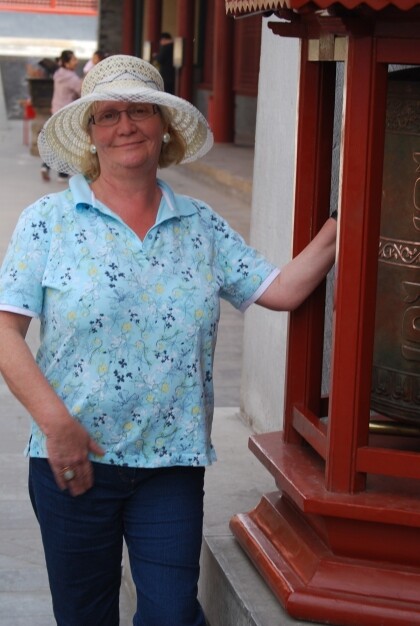
Jutta with sunhat
The third day in Beijing was a very special event because our tour guide Chen had pointed out to us that we would do that day for a long walk through the "Forbidden City". Here we experienced the hottest day of our whole China tour with a temperature of 28 deg. C. An elderly participants in our group could already no longer in the garden of the Imperial Palace. Chen organized its transport and we met him later on the bus again . According forewarned we had enough drinks in our red backpack (with two matching external pockets) there. In the lower grounds of the Imperial Palace Jutta bought as sun protection a light hat that suited her very well and became the companion during the entire trip.
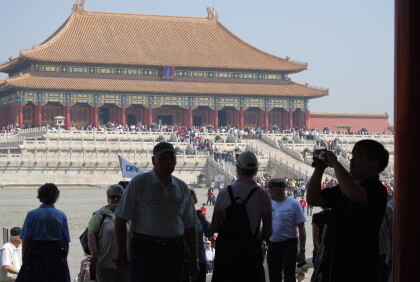
Hall of Supreme Harmony
In order not to go with the expected crowds to have, we have passed through the Imperial Palace in north-south direction and thus gained a very good impression. After our return to Germany, we have again the monumental movie " The Last Emperor " (1988 won 9 Oscars). Italian director Bernardo Bertolucci followed in 1987, the fate of the last Chinese emperor Pu Yi in the original buildings of the Imperial Palace. We found it fascinating to be reminded in this way to our experiences in Beijing.
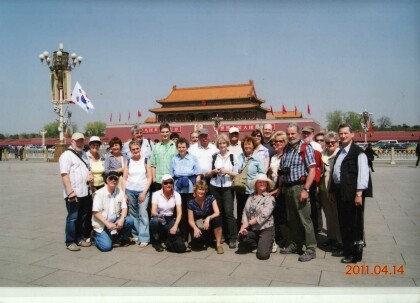
DERTOUR Our tour group in Beijing
After leaving the Imperial Palace by the South Gate (with Mao 's picture on the front page) we reached via a tunnel to the famous Tiananmen Square. There was time for a souvenir photo of our DERTOUR travel group with 27 participants. In the square there was very warm and loud (on large video screens Chinese folklore was played. From demonstrations and protests had nothing to recognize (1989 came here to a massacre of students with tanks). Prior to Mao 's Mausoleum , we were able to observe a large snake of the Chinese, who were waiting on the intake several hours. So this was modern China at the gates of the medieval Imperial Palace.
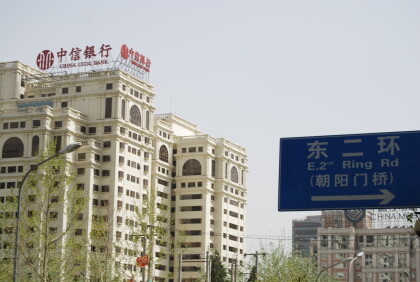
Modern Beijing
After a short walk we came to a total of three hours ( for 9 clock in the morning) back to our bus that took us to lunch. After that was the visit to the Temple of Heaven (the Beijing landmark ) on the program.
Visiting the Temple of Heaven with the Hall of Prayers harvest was the third tourist attraction on 3 Day in Beijing. After the walk through the Imperial Palace in north-south direction and then over the Tiananmen Square we took our bus to Temple of Heaven, which is the landmark of Beijing. The altar is located approximately 2.5 km south-east of the square of heavenly peace.
Through a gallery that leads to the east gate, you come to a green area, situated where amateur musicians regularly. There are nine altars in Beijing, which are arranged according to geomantic ritual - cosmological- criteria. The best preserved is the Temple of Heaven, built in 1420 and is open to the public since 1912. With the annual ritual of the emperor asked for the start of spring the successful culture of the seed. This was one of his most important tasks. Relatively early (against 15 clock) were back at the hotel.
The 4th Day (on Friday , 15 April 2011) was also the last day in Beijing, as we lead the night train in the 1000 km distant Xi'an. That's why we had been in the morning leave our bags, which were then brought to the main station. Before us Chen had expressly pointed out to close absolutely sure the trunk. We saw this until the following morning in Xi'an again. Our toilet bag and the sleeping stuff we handed in our two backpacks, we could also leave the bus. On the subject of water, I have a supplementary information: Even in the modern hotels in China should not drink the water. Therefore, two small bottles of water were each there for the morning toilet in the bathroom. The unused water took for our daily requirement with.
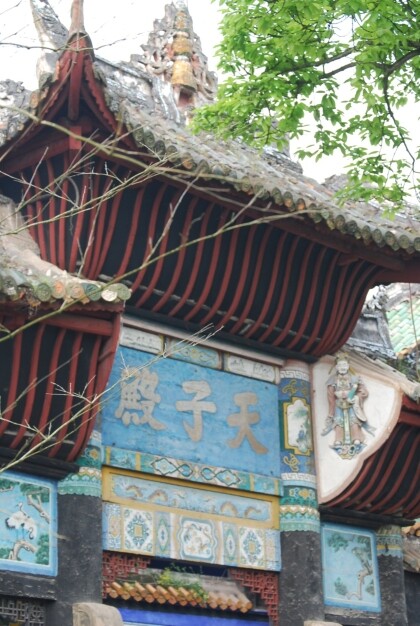
The lamasery
Already at 9 clock we went to the Lama Temple Monastery, which is inhabited by monks. This is an exception, as most temples monasteries are no longer in operation and are maintained by the state as monuments. In the case of the Lama Temple Monastery, the monks have a status of state employees, which are also subject to state control. However, they are held, is possible to finance itself: through entrance fees, by selling souvenirs and also by religious services.
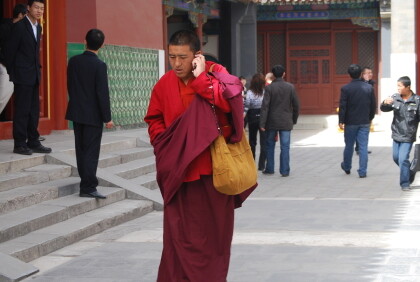
Monk in the lamasery
During the Cultural Revolution (1966-1969), the Lama Temple Monastery was under the special protection of Zhou Enlai (Premier of the People 's Republic of China) and was therefore not destroyed. Access is via a side entrance in front gardens with a bell and drum tower. The individual temples are dedicated to Lord Buddha. There are also Tibetan prayer wheels there (in front of a prayer wheel I Jutta photographed with her Chinese summer hat).
Our lunch we enjoyed in a special restaurant that I would like to mention explicitly. It was called " Western Restaurant " and all the dishes were arranged on a long buffet, from which you could use, depending on your mood. There were a lot of different portions of meat. This European way of eating, we
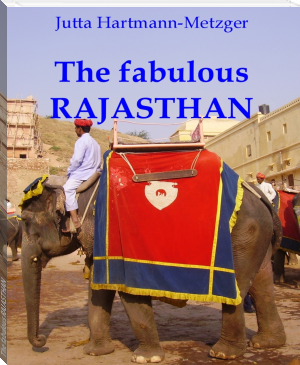




Comments (0)